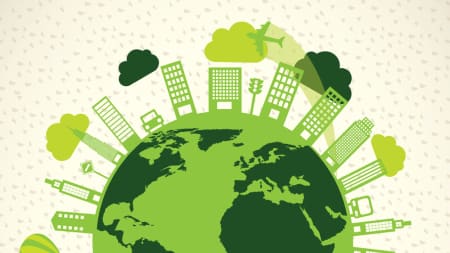Celebrating Earth Day in the Construction Industry
In the spring of 1970, Senator Gaylord Nelson created Earth Day to raise awareness of the importance of protecting our planet. Twenty million Americans marched and protested in favor of creating a day all about our planet. Thanks to the movement by Senator Nelson, United States Congress approved a new federal agency in December 1970. This agency would focus specifically on environmental issues, nature preservation and taking care of our earth. The U.S. Environmental Protection Agency was born.
In celebration of those marches in support of Senator Nelson, Earth Day is celebrated every spring.
The environment and construction are so intertwined. Unfortunately the construction industry historically has played a more negative role in impacting the environment. Building and construction are responsible for 39% of all global carbon emissions. Traditional manufacturing and building processes put strains on our planet and on our resources. Over the past decade, however, recognition of these challenges has helped to drive innovation and positive change in the construction industry.
The construction industry builds our world up. It makes sense that we want to do so in a responsible way. This Earth Day, it’s important to highlight the changes and advancements that are happening in construction to help keep our planet safe, happy, healthy and thriving.
Making Greener Machines
Construction machines consume fuel, produce tailpipe emissions, contribute to noise pollution and – on top of it all – are one of the biggest money-consumers for project budgets. Greener electric construction machines are one of the most exciting up-and-coming green trends in construction we want to celebrate this Earth Day.
Whether it’s a hybrid piece of equipment or one of the newest fully electric machines, electric construction equipment will make construction sites quieter, be kinder to project budgets with lower fuel costs and drastically reduce greenhouse emissions produced by the industry.
The technological advancements needed in order to power such high-performing machines through electricity and batteries are incredibly inspiring. As these machines begin to enter the market hopefully we will see major drops in greenhouse gas emissions around the world.
Sourcing New and Innovative Construction Materials
Another big change in sustainability for the construction industry has been in the form of new and innovative building materials. 3D printing houses, using bales of hay as insulation and creating concrete out of paper pulp are just a few examples of many more sustainable materials being used. Most of these materials produce less waste and create less garbage as well. One of the more popular forms of sustainable materials is cross-laminated timber. There has been a rise in wooden buildings all over the world.
Innovation in construction materials not only makes construction more sustainable but also challenges the initial design and engineering processes that go into the buildings in the first place. Wood, for example, creates an entirely different aesthetic to a building. With more natural materials, many projects are beginning to focus more on adding more windows and natural light as well as landscaping and having lush green spaces and gardens. It’s changing building design altogether.
Improved Construction Recycling Programs
Recycling programs are huge when it comes to the future of building materials – concrete in particular. Concrete is the most used building material in the world. It’s also the one that causes the most problems. Sand shortages and black-market sand deals have made concrete one of the most controversial building materials out there. Recycling programs for concrete have grown over the years and definitely play a part in making this material more sustainable.
Outside of concrete, recycling harvested materials such as wood, brick and stone can make demolition or remodeling way more sustainable. Plus, reclaimed materials are a growing trend as environmentalism and the “reduce, reuse, recycle” movement grows. Selling these reclaimed materials can be a great additional income, especially for smaller contracting companies.
LEED Certification and Greener Building Standards
LEED Certification is growing in popularity and generates billions of dollars in green-focused construction jobs. Between 2011 – 2014, green construction added over $167 billion USD to the national GDP.
Green construction buildings cost less to run overall, produce less greenhouse gas emissions and use less energy and water compared to traditional buildings. These factors appeal more to building owners and have been a big part of the reason they have grown in popularity over the years.
The future of large projects in the construction industry really depends on contractors being knowledgeable in LEED and green construction processes. Being able to follow these green trends will be a huge selling point and could be the deciding factor between two contracting companies bidding on projects.
The increasing popularity and recognition of green buildings is great for the planet and offers a unique challenge for contracting companies in the future.
What You Can Do This Earth Day
This year, embrace Earth Day wherever you are. These trends and innovations are a great sign that things are changing for the better for green and sustainable construction. On a smaller scale, there are a few things you can do on-site to embrace this day. These include:
- A lunchtime garbage pickup to clean up your construction site and the areas around it
- Do your best to reduce idling times on machines and vehicles
- Make sure that your break room or trailer has recycling bins
- Ensure that proper disposable processes are in place for chemicals on site
- Educate yourself about LEED Certifications and green building processes
Celebrating Earth Day: The Future is Green Construction
The COVID-19 pandemic has highlighted the future of taking care of our planet. This earth day is just one of many but there are things that the construction industry as a whole can go to make our world greener for longer.

